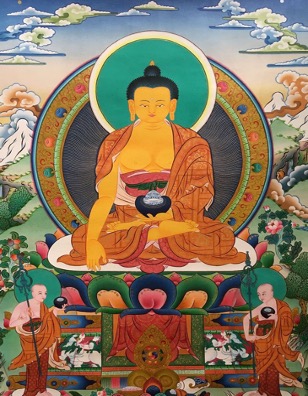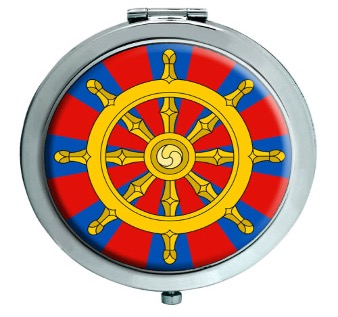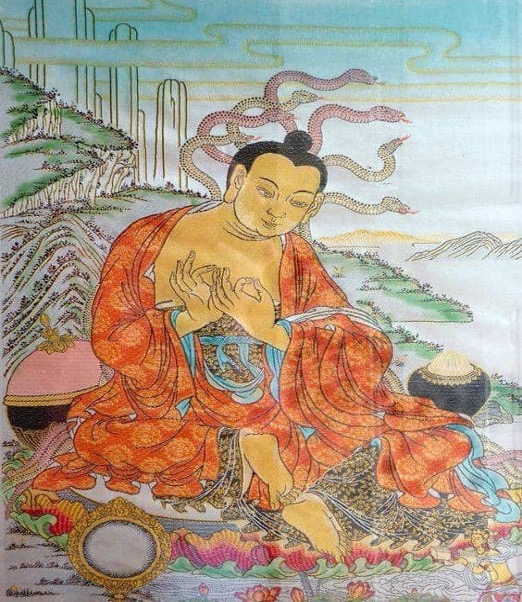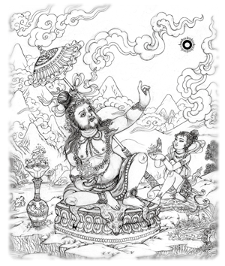Buddhism has its origin in ancient India in 6th century BC after the famous Indian prince Siddhartha renounced place life and chose to live the life of a mendicant.
His lived six years in solitude with strict discipline while meditating and fasting which culminated his attainment of enlightenment ‘Bodhi’. One who attains the ultimate Bodhi is the ‘awakened one’ and hence he became known as ‘Buddha’, the ‘Fully Enlightened One’. Even today there is a Bodhi Tree at the exact location where he attained enlightenment. Situated in Bodh Gaya in Bihar India, today it is one of the most sacred Buddhist pilgrimage sites.
After Buddha’s enlightenment he taught his wisdom through simple discourse, parables and stories and mostly by living an inspirationally wholesome life.
Most disciples shaved their hair and beard put on maroon robes, attained high realisation and became arhats. They lived on alms and took vows not to own property, house, family or wealth but seek to cultivate stillness, sincerity, serenity and simplicity which are unfolded through realising the luminous nature of the mind.
Through self-discipline, meditation and wisdom, the path Buddha promoted is to restrain desire, hatred and ignorance as the root cause of all miseries.
Those who became committed followers of his Dharma teachings formed a sacred fellowship known as ‘Sangha’. The spiritual community of practitioners are comprised of a minimum four members including an ordained monk, nun, lay man and lay woman devotees – all working harmoniously with mutual respect and kindness. So, from the ‘Buddha’, his teachings became and known as ‘Dharma’ and those who followed and practised became known as ‘Sangha’.
Buddha, Dharma and Sangha are called ‘Three Jewels’. A Buddhist person must have formally gone for refuge in the Three Jewels and stays engaged and belongs to such a fellowship.

The discourses known as ‘Sutras’ were recollected by Buddha’s elder disciples and were retold word for word by adding a prologue which described who, where, when, why and what promoted the discourse ‘Thus I have heard once…” and ending with some concluding remarks. Many of his disciples who attained Arhathood acquired an art of non-forgetfulness.
Three eminent disciples Mahakashyapa, Ananda and Upali were the compilers of the three collections known as ‘Tripitaka’ sponsored by King Ajatashatru of Rajgir three months after the Mahaparinirvana of the Buddha. Around 2nd century AD, ‘Tripitaka’ consisting of ethical codes (vinaya), discourse (sutra) and metaphysical teachings (abhidharma) were committed into writing in Pali, Sanskrit and Prakrit languages. They contain collections of teachings that are remedies to the three poisons of desire, hatred and ignorance.
Buddha’s teachings soon became an established path of spiritual development focussed on self-discipline, compassion and wisdom by leading a non-violent way of life. The unity of the practice of calm abiding meditation and special insight meditation boosts the clarity of the mind and empower to realise the true nature of reality as it is. Today in the 21st century, ‘Buddhism’ is known as a distinct spiritual wisdom that does not adhere to a creator god but adds much sanity, wisdom and compassion to the world. Anyone who hears Dharma finds a way to live with great dignity, confidence and gentleness.
Important: To find out more about our Buddhism classes we offer at our centre (both in-person and online), go to the info page here >>
Core Buddhist Teachings
The core Buddhist teachings are contained in The Four Noble Truths, The Four Seals, and the Eight-fold Noble Path.
The Four Noble Truths
The Four Noble Truths are:
1. Truth of Sufferings
2. Truth of Origin
3. Truth of Cessation
4. Truth of Path
The Truth of Sufferings must be understood and accepted with humility and dignity as fact of life. As the Truth of its Origin is one’s own flawed conducts and afflictive emotions, they must be abandoned by making gradual correction with introspection. By knowing how to put an end to the unconscious causes, the Truth of Cessation must be realised. And by adhering to live according the eight-fold noble path, the Truth of Path must be practised and bring a positive change in one’s life.
The Four Seals
The basic tenets of Buddhist teaching are straightforward and practical. They are known as ‘Four Seals’:
- All contaminated emotions are suffering (dukkha)
- All that are conditioned are impermanent (anitya)
- There is no autonomous and truly existent self (anatma)
- Nirvana, the absence of sorrow is peace
Sometimes, they are referred as the Three Principle Marks of the Path’, dukkha, anitya and anatma when the last one is omitted. Understanding why we suffer so much when we least want it, is the question and a mystery of all mysteries. Buddhist teachings answer it by saying that psychology and physics of sufferings must be discovered and understood. This understanding should be based on rational, logical and sensible teachings as how to live and accept the sufferings as part and nature of all living beings.
Buddhism is least preoccupied with abstract ideas of how the world began and how it will come to an end. Problems and sufferings are created by the ‘unconscious mind’ and becoming conscious of the unconscious mind is the good starting point. Buddhist practices are the means of becoming aware of the subjective unconscious: to change one’s deluded view and know how sufferings are created unconsciously under the sway of afflictive emotions.
As people say ‘life stinks’ one should look and see why it is so and then make conscious change through reflection and meditation. As one discovers how unskilful actions are performed unconsciously due to strong unresolved negative emotions and old habits, this awareness teaches how to stop sufferings by knowing how to abandon the mental problems from where they originate. By embarking on the Eight-fold Noble Path, one can gradually develop the life skills and possess the qualities of self-discipline, awareness, kindness, and wisdom.
Eight-fold Noble Path
Adherence to the Eight-fold Noble Paths is symbolised by the Eight Spoked Wheel of Dharma. A person who accepts the ‘Four Seals’ and follows the Dharma, has found the vehicle or the path that will eventually leads to gradual reduction to complete cessation from sorrow. Practising the path means one ‘walks the talk’ by embracing the eightfold noble path:

- Right View: Adopt the Four Seals of Dharma
- Right Intention: Adopt to practice kindness, compassion and altruism
- Right Speech: Use soft, gentle, positive and skilful language and give love
- Right Action: Adopt a non-violent, generous, honest and skilful conduct
- Right Livelihood: Chose a profession that has least or no harm to others
- Right Effort: Maximise benefit and eradicate even slight harm
- Right Mindfulness: Be aware of one’s own thoughts, feelings and opinions
- Right Meditation: Gain training of the mind through authentic meditation
Going For Refuge
Buddhist do not believe in a theistic god or deity but rather by one’s own conscious choice of becoming more aware on the path of mindfulness and enlightenment. Individuals who wish to voluntarily engage on this path become Buddhists by going through a simple ceremony called ‘Going For Refuge’. The experience developed within the Buddhist tradition over thousands of years has created an incomparable resource for all those who wish to follow a path – which ultimately culminates in Enlightenment or Buddhahood. Stories of how people found refuge and became good are the constant sources of inspiration in knowing how the path helps the person to grow spiritually and emotionally. An enlightened being sees the nature of reality absolutely clearly, just as it is, and lives fully and naturally in accordance with that vision. This is the goal of the Buddhist spiritual life, representing the end of suffering for anyone who attains it.
A good Buddhist should look at the flaws and problems of oneself and others with this understanding and impart a compassionate response while knowing the lack of true existence from their own side. Most leading Buddhists are monastics and live a very strict life of many rules of self-control from desire, status, wealth and self importance. Most cultural Buddhist communities largely centres around their community of Bhikhus, monks, lamas, roshis, nuns or teachers. Increasing numbers of modern educated people are adopting Buddhism as a philosophy of life and try to disassociate it as a ‘religion’. Even the Dalai Lama has advocated some of the key Buddhist ideas as cornerstone of how secular ethics may be promoted by going ‘Beyond Religion’.
The Legacy of Emperor Ashoka
A number of Indian kings played a significant role to promote Buddhism. Buddhism grew slowly in the Indian sub-continent and especially through the emperor of India, Ashoka (c. 273-237 B.C.E.), who ruled most parts of the Indian subcontinent and became a convert.
Ashoka was horrified at the human toll taken by his conquests in pursuit of a unified Indian Empire, and he embraced the Buddha’s teachings of non-violence. He embraced the spiritual guidance of Arhat Upagupta (the fourth Buddhist patriarch), vegetarianism became state policy and Buddhism spread across most of India.
Ashoka’s son Mahinda went to Sri Lanka and spread Buddhism there. Ashoka unearthed many of the old Buddhist stupas and distributed the Buddha relics all over of his domain and ordered to build 84,000 stupas in order to purify his misdeeds and cause the spread Buddhism in many countries as far as Afghanistan and Central Asia.
Ashoka’s edicts in support of the Buddhist precepts against harming humans and animals and in favour of religious tolerance were engraved on large rocks and stone pillars for all the people to read. He issued a royal decree requiring the locals to protectBuddhist monuments and that the villager’s tax be waived. Even in the 21st century Ashokan pillars are still standing in some of the historical places like Lumbini, Vaishali, Sarnath etc.
Three Vehicles in Buddhism
Buddhism gradually divided into a number of schools and sub-schools. They were largely known as the 18 Nikaya schools which were largely differentiated by minor monastic codes of practice.
The two main schools are Theravada and Mahayana. The Theravada Buddhism largely spread south and east from India into what is now Sri Lanka, Thailand, Myanmar, Laos, Cambodia, Vietnam, and Bangladesh. Theravada is mainly a monastic Buddhism that largely appeals to the male population. While Buddha was against caste system in India, with this unintended discrimination against women and lay people, there is a sort of caste system in Theravada between the ordained, lay person and also between the genders. The ordained Sangha members are very segregated from the ordinary people and worshipped as if they are holy men. Women are treated as the cause of all the trouble.
The Mahayana developed around the 1st century B.C.E., mainly in North western and Southern India, which advocated a more liberal way to adapt the Vinaya codes according to time and place especially where Buddhism came into contact with foreign cultures. Both Theravada and Mahayana accept the central tenets of the ‘Four Seals of Dharma’, ‘Eight-fold Noble Paths’ and ‘Going to Refuge in the Triratna’. The faithful devotees have to purify themselves by following the moral and ethical precepts of the Buddha whether the emphasis is monasticism or altruism. Mahayanist monastics take additional Bodhisattva vows of altruism to serve sentient beings until they are all enlightened. The Mahayanist monks are friendly towards ordinary people. Mahayana spread north in the 1st century to the Himalayan region, Central Asia, and China, later to Korea and Japan, and in the 7th century to Tibet. Nagarjuna is key figure for Mahayana ideology.

Bodhisattvas In Buddhism
Both Theravada and Mahayana accept the basic tenets of Buddhism, but Theravada stresses the liberation of the individual from the cycle of existence. Their main ideal is the arhat, or fully liberated being who experiences nirvana for himself. Stories of Arhats play a significant part of Theravadin ideal and inspiration.
In contrast, Mahayana developed the ideal of everyone becoming a Bodhisattva – an enlightened being who, rather than experiencing complete nirvana, returns to help bring all sentient beings to enlightenment. This belief is predicated on limitless lifetimes to develop limitless abilities with which to help others achieve enlightenment.
A Bodhisattva is a being who, out of compassion, has made a vow to reach enlightenment for the sake of others, and who by definition is on the path to Buddhahood. However, Bodhisattvas exist at various levels of development over many lifetimes; in the Mahayana tradition there are earthly and transcendent bodhisattvas. The former are still ordinary beings, male or female, who have taken Bodhisattva vows and are developing their skills at helping others from the path of accumulation onwards.
Some such Bodhisattvas who have attained bhumis may repeatedly return to the world and assume different incarnations either formally recognised or remain in incognito to serve all sentient beings. The latter, who can be called ‘celestial Bodhisattvas’, are possessed of perfect wisdom and are no longer subject to samsara. There are generally many Bodhisattvas but primarily eight Bodhisattvas i.e Avalokiteshvara, Manjushri, Vajrapani etc.
Vajrayana Buddhism
Vajrayana Buddhism is branch of Mahayana Buddhism that largely follows more esoteric teachings in which there are pantheon of deities, who are transcendent Bodhisattvas who may manifest in various peaceful, wrathful, male or even female, and few celestial beings are more highly revered by Tibetan Buddhists than Tara, the embodiment of the feminine aspect of compassion. Each deity is an object and subject of meditation specific quality of the Buddha.
In Vajrayana, in additional to monastic vows and Bodhisattva vows, the practitioner has to be initiated and receives Tantric vows called ‘samayas’, which are secret practices. The opposite gender is treated with respect as all beings endow Buddha nature and despising women is a Vajrayana transgression.
The Secret Vehicle

Vajrayana teachings were practised in secret for many centuries before they were revealed in 200 B.C.E. Recent discovery of old statues of Tara and other deities from excavation in Sri Lanka and many parts of India is evident that Vajrayana was practised in ancient times.
Often known as the secret vehicle, in the early days Vajrayana was taught only to a few chosen disciples and not given to large public gatherings. But when Vajrayana spread to Tibet in 6th century and since it has taken a strong foothold in Tibet and all neighbouring countries in the Himalaya region and also in Japan, Mongolia and China, the Vajrayana practices are equally available and open to all people. This is a warm and inclusive approach without much discrimination between age, gender or ordained/lay person, however requires everyone to receive the appropriate empowerment from authentic lineage masters.
Ideals of the Vajrayana Buddhists are the Mahasiddhas such as Virupa, Tilopa, Naropa etc. who were all monastics in their youth but later they became wandering holder ascetic masters known as ‘Mahasiddhas’.
To read more about Tibetan Buddhism, which is the form of Buddhism our centre practises, click here >>
